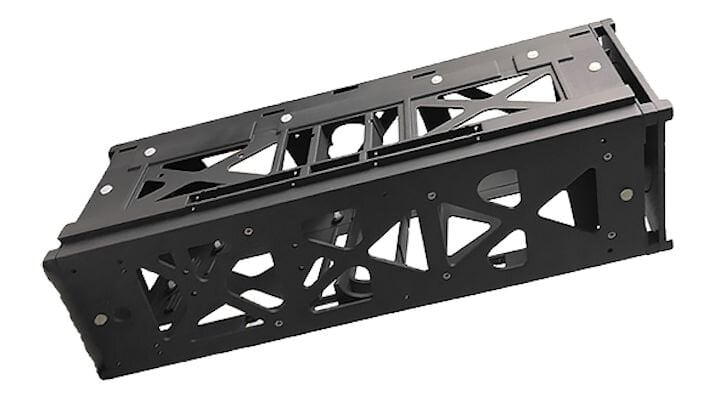![A 3D printed Cubesat U3 frame [Source: CRP Technology]](https://fabbaloo.com/wp-content/uploads/2020/05/image-asset_img_5eb08d1d88007.jpg)
An experiment by CRP Technology demonstrates the possibility of 3D printing spacecraft.
Of all the possible applications of 3D printed parts, it may be that space travel could be the most challenging. Parts must undergo tremendous vibration, withstand extreme heat and extreme cold – sometimes simultaneously, too. They must also behave nicely by not outgassing any substances that could interfere with spacecraft operations.
As a result, we haven’t seen a great many 3D printed spacecraft parts. However, it seems that CRP Technology has been able to do so with their new Windform XT 2.0 material.
The Italian company has developed high performance thermoplastic powder material for additive manufacturing equipment for many years. Their Windform product has been used for many challenging applications, often in sports equipment, such as their recent foray into professional motorcycle racing.
3D Printing Cubesats
CRP Technology worked with Laboratoire InterUniversitaire des Système Atmosphérique (LISA) of Universite Paris-est Creteil (UPEC) to develop a 3U Cubesat frame. If you’re not familiar, “Cubesats” are a standard size for a micro-satellite. A Cubesat must fit within a 10 × 10 × 11.35 cm volume, and weigh less than 1.33kg. They are a financially accessible approach for some to deploy functional satellites to orbit, albeit of a small size.
Cubesats are typically not launched on their own, but instead piggyback on existing launches of larger satellites by using up any usable launch capacity. Frequently they are launched in multiples, with several different Cubesat projects sharing the carriage to orbit.
CRP / LISA Project
That leads us to the CRP / LISA project. Here they designed and 3D printed a 3U Cubesat frame, which is designed to hold three Cubesats in the same way that a 10U rack might hold ten servers in a computer room.
The goal of the project was to demonstrate that it was possible to 3D print and launch such a structure successfully. CRP Technology explained the challenge facing the design:
“CubeSat Structure is critical as it has to fulfill the launch-pad (P-Pod) requirements in terms of dimension, flatness and roughness, but also for outgassing, UV resistance, thermal expansion, and general space constraints.”
![Detail view of 3D printed Cubesat U3 frame [Source: CRP Technology]](https://fabbaloo.com/wp-content/uploads/2020/05/image-asset_img_5eb08d1dd9a60.jpg)
Even more challenging was the fact that in a space project, you get only one chance to make it work. If it fails, the mission is over. That places a tremendous amount of pressure on the teams involved and generates a great deal of pre-launch testing. This is something few 3D printed components go through.
3D Printed Space Components
Why is this project so important? If it’s shown to be possible to produce functional 3D prints for space applications, then we will soon see many more examples. This is because weight is a critical resource and must be reduced as much as possible. 3D printing enables the creation of unusual geometries that can provide the necessary function, but with potentially significant weight loss.
Given this development, it may be that CRP Technology will be approached to partner in additional space applications seeking to take advantage of 3D printing technology.
Via CRP Technology

